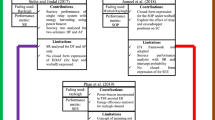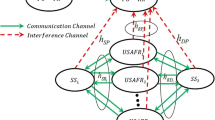Abstract
This paper examines the Secrecy Outage Probability (SOP) and outage performance of an energy efficient Spatial Modulation (SM) in a bidirectional Decode and Forward (DF) Cooperative Cognitive Radio (CCR) system with the presence of an eavesdropper. In the proposed system, both primary and secondary users use SM technique to enhance the spectral efficiency and energy efficiency of the bidirectional system. The two primary users swap their information with the aid of a secondary user, which acts as a bidirectional DF relay node. Time Switching Relaying protocol-based energy harvester is employed in the secondary user to harvest the energy from both SM operated primary users. Secondary user information is embedded with jamming signal to confuse the eavesdropper. The SOP of the primary user and secondary user are examined in the presence of an eavesdropper. Furthermore, the lower bound and upper bound outage probability of the proposed bidirectional CCR system with Physical Layer Network Coding and SM are derived with respect to the harvested energy. Simulation results are presented to provide the functional perception of the proposed system behavior and emphasize the effect of different system parameters.







Similar content being viewed by others
Data Availability
The datasets analysed during the current study are not publicly available but are available from the corresponding author on reasonable request.
References
Shiu, Y.-S., Chang, S., Wu, H.-C., Huang, S., & Chen, H.-H. (2011). Physical layer security in wireless networks: A tutorial. IEEE Wireless Communications, 18(2), 66–74.
Yang, N., Wang, L., Geraci, G., Elkashlan, M., Yuan, J., & Renzo, M. D. (2015). Safeguarding 5G wireless communication networks using physical layer security. IEEE Communications Magazine, 53(4), 20–27.
Mesleh, R., Haas, H., Sinanovic, S., Ahn, Chang Wook, & Yun, Sangboh. (2008). Spatial Modulation. IEEE Transactions on Vehicular Technology, 57(4), 2228–2241.
Basar, E. (2016). Index modulation techniques for 5G wireless networks. IEEE Communications Magazine, 54(7), 168–175.
Jeganathan, J., Ghrayeb, A., & Szczecinski, L. (2008). Spatial modulation: Optimal detection and performance analysis. IEEE Communications Letters, 12(8), 545–547.
Zhang, M., Miao, W., Shen, Y., Huang, J., Zhang, S., Zeng, Z., et al. (2019). Joint spatial modulation and beamforming based on statistical channel state information for hybrid massive mimo communication systems. IET Communications, 13(10), 1458–1464.
Yang, P., Xiao, Y., Xiao, M., Zhu, J., Li, S., & Xiang, W. (2019). Enhanced receive spatial modulation based on power allocation. IEEE Journal of Selected Topics in Signal Processing, 13(6), 1312–1325.
Liu, Y. (2016). Wireless information and power transfer for multirelay-assisted cooperative communication. IEEE Communications Letters, 20(4), 784–787.
Khandaker, M. R., & Wong, K.-K. (2014). Swipt in miso multicasting systems. IEEE Wireless Communications Letters, 3(3), 277–280.
Zeng, Y., & Zhang, R. (2015). Full-duplex wireless-powered relay with self-energy recycling. IEEE Wireless Communications Letters, 4(2), 201–204.
Nasir, A. A., Zhou, X., Durrani, S., & Kennedy, R. A. (2013). Relaying protocols for wireless energy harvesting and information processing. IEEE Transactions on Wireless Communications, 12(7), 3622–3636.
Lee, K., Bang, J., & Choi, H.-H. (2020). Secrecy outage minimization for wireless-powered relay networks with destination-assisted cooperative jamming. IEEE Internet of Things Journal, 8(3), 1467–1476.
Diffie, W., & Hellman, M. (1976). New directions in cryptography. IEEE Transactions on Information Theory, 22(6), 644–654.
Wyner, A. D. (1975). The wire-tap channel. Bell System Technical Journal, 54(8), 1355–1387.
Hamamreh, J. M., Furqan, H. M., & Arslan, H. (2018). Classifications and applications of physical layer security techniques for confidentiality: A comprehensive survey. IEEE Communications Surveys and Tutorials, 21(2), 1773–1828.
Laneman, J., Tse, D., & Wornell, G. (2004). Cooperative diversity in wireless networks: Efficient protocols and outage behavior. IEEE Transactions on Information Theory, 50(12), 3062–3080.
Mehmood, G., Khan, M. Z., Abbas, S., Faisal, M., & Rahman, H. U. (2020). An energy-efficient and cooperative fault-tolerant communication approach for wireless body area network. IEEE Access, 8, 69134–69147.
Mao, M., Cao, N., Chen, Y., & Zhou, Y. (2015). Multi-hop relaying using energy harvesting. IEEE Wireless Communications Letters, 4(5), 565–568.
Rabie, K. M., Adebisi, B., & Alouini, M.-S. (2017). Half-duplex and full-duplex af and df relaying with energy-harvesting in log-normal fading. IEEE Transactions on Green Communications and Networking, 1(4), 468–480.
Van, N. T. P., Hasan, S. F., Gui, X., Mukhopadhyay, S., & Tran, H. (2016). Three-step two-way decode and forward relay with energy harvesting. IEEE Communications Letters, 21(4), 857–860.
Shrestha, S., & Chang, K. (2008). Analysis of outage capacity performance for cooperative df and af relaying in dissimilar rayleigh fading channels, In: 2008 IEEE International Symposium on Information Theory, vol. 1. IEEE, 494–498.
Xu, D., Yu, X., Sun, Y., Ng, D. W. K., & Schober, R. (2020). Resource allocation for irs-assisted full-duplex cognitive radio systems. IEEE Transactions on Communications, 68(12), 7376–7394.
Aswathi, V., & Babu, A. (2021). Performance analysis of noma-based underlay cognitive radio networks with partial relay selection. IEEE Transactions on Vehicular Technology, 70(5), 4615–4630.
Lu, K., Fu, S., Qian, Y., & Chen, H.-H. (2009). On capacity of random wireless networks with physical-layer network coding. IEEE Journal on Selected Areas in Communications, 27(5), 763–772.
Chan, T.-T., & Lok, T.-M. (2021). Utilizing interference by network coding for simultaneous wireless information and power transfer. IEEE Wireless Communications Letters, 10(6), 1349–1353.
Maji, P., Roy, S. D., & Kundu, S. (2018). Physical layer security in cognitive radio network with energy harvesting relay and jamming in the presence of direct link. IET Communications, 12(11), 1389–1395.
Banerjee, A., Maity, S. P., & Roy, S. (2018). On outage secrecy minimisation in an energy harvesting relay assisted cognitive radio networks. IET Communications, 12(18), 2253–2265.
Yang, Q., Ding, J., & Hu, A. (2019). Secrecy outage performance analysis of df cognitive relay network with co-channel interference. Wireless Personal Communications, 107(1), 549–564.
Li, Q., Wen, M., Basar, E., Poor, H. V., & Chen, F. (2019). Spatial modulation-aided cooperative noma: Performance analysis and comparative study. IEEE Journal of Selected Topics in Signal Processing, 13(3), 715–728.
Gradshteyn, I. S., & Ryzhik, I. M. (2014). Table of integrals, series, and products. Cambridge: Academic press.
Author information
Authors and Affiliations
Ethics declarations
Conflict of interest
No funding was received to assist with the preparation of this manuscript. The authors declare that they have no conflict of interest.
Additional information
Publisher's Note
Springer Nature remains neutral with regard to jurisdictional claims in published maps and institutional affiliations.
Rights and permissions
About this article
Cite this article
Ravindran Unnithan Jalaja, R., Velmurugan, P.G.S. & Thiruvengadam, S.J. Performance Analysis of Energy Efficient Spatial Modulation in Bidirectional Cooperative Cognitive Radio System with Eavesdropper. Wireless Pers Commun 125, 101–118 (2022). https://doi.org/10.1007/s11277-022-09543-y
Accepted:
Published:
Issue Date:
DOI: https://doi.org/10.1007/s11277-022-09543-y




